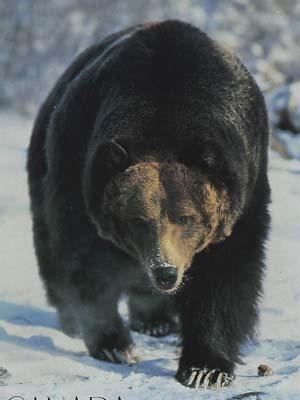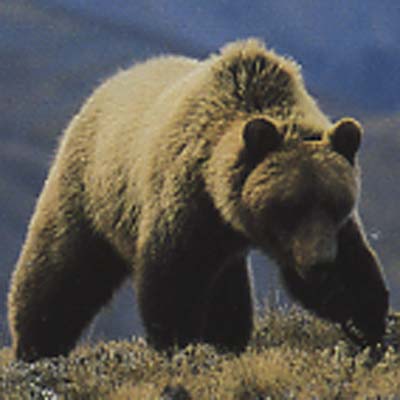

The Great Bear Rainforest
Auf der Nordküste von Westkanada wird dem großen
Bären Rainforest aufgestellt. Die Größe von diesem die Regierung
betreffend "ungeschützten" rainforest, bestehend aus 1.000 Einjahreszederbäumen,
ist- ungefähr 3.2 Million Hektars (8 Million Morgen.) Jedes Jahr kommen
die grizzlies unten von den hohen Gebirgsstrecken zum Nekite Fluß zur
Zufuhr nach den zurückgehenden laichenden Lachsen.
On the North Coast of western Canada is situated the Great Bear Rainforest.
The size of this governmentally "unprotected" rainforest, consisting
of 1,000 year old cedar trees, is approximately 3.2 million hectares (8 million
acres.) Each year the grizzlies come down from the high mountain ranges to the
Nekite river to feed upon the returning spawning salmon.


Ein grizzly Bär kann bis 390 Kilogramm wiegen. (800
zerstößt) und das wohle Einziehen nach den laichenden Lachsen kann
bis 2.7 Kilogramm gewinnen. (6 zerstößt zerstößt), pro
Tag. Die Bären müssen oben mästen bevor sie hybernate (Schlaf)
für den langen kalten Winter. Es gibt z.Z. der Bär 40 bis 50, der
unten zum Fluß kommt einzuziehen. Ein Muttergrizzly Bär kann Geburt
bis zu vier Jungen (Babybären) geben. Der Mutterbär interessiert sich
für ihre Junge für, drei Jahre bevor sie sie heraus in die Welt sendet,
um für selbst abzuwehren. In Kanada werden ungefähr 5 bis 10 Leute
zum Tod durch Bären jedes Jahr übel zugerichtet. Wilde Bären
sind, besonders ein grizzly Bär sehr gefährlich.
A grizzly bear can weigh up to 390 kg. (800 pounds) and well feeding upon the
spawning salmon can gain up to 2.7 kg. (6 pounds pounds) per day. The bears
need to fatten up before they hybernate (sleep) for the long cold winter. There
are currently 40 to 50 bear coming down to the river to feed. A mother grizzly
bear can give birth up to four cubs (baby bears). The mother bear will care
for her young for three years before she sends them out into the world to fend
for themselves. In Canada, approximately 5 to 10 people are mauled to death
by bears each year. Wild bears are very dangerous, especially a grizzly bear.
Aufgestellt auf dem Eingang (Smith) ist das Führen
in den Nordnekite Fluß die großer Bär Hütte. Die Hütte
selbst, Interesse genug, wird durch Solar- und Energieenergie angetrieben. Der
Eingang wird durch sehr hohe Berge umgeben und nicht nur einen Besucher sehen
grizzly Zahnräder, aber auch einmacht; Schwarzbären, Wölfe, Otter
und kahle Adler. Die Hütte stellt Tageszeitung Touren für Leute zur
Verfügung, die von auf der ganzen Erde kommen, die splindine Landschaft
und die Wildnis zu sehen. Die Hütte kann mit dem Boot oder mit dem Flugzeug
erreicht werden. Wenn Sie das Wassertaxi von der Vancouver Insel zur Hütte
nehmen, gibt es eine gute Wahrscheinlichkeit, daß Sie Delphine, Dichtungen,
Walruses und Wale sehen.
Situated on the inlet (Smith) leading into the North Nekite river is the Great
Bear Lodge. The lodge itself, interest enough, is powered by solar and energy
energy. The inlet is surrounded by towering mountains and not only can a visitor
see grizzly gears, but also; black bears, wolves, otters, and bald eagles. The
lodge provides daily tours for people that come from all over the world to see
the splindine scenery and wildlife. The lodge can be accessed by boat or by
aircraft. If you take the water taxi from Vancouver Island to the lodge there
is a good chance that you will see dolphins, seals, walruses, and whales.
Quiz:
1. Is the rain forest governmentally protected or unprotected?_____________________
2. Why do the bears come to the river each year?_____________________
3. What is a baby bear called? __________________________
4. What is the weight a grizzly can grow to?___________________________
5. How much weight can a grizzly acquire each day upon feeding on the salmon.
_____________________________6. Water taxi is one way of reaching the lodge. What is the other?
________________________________7. Name the bird mentioned in the above article?__________________________
8. How old is a cub before the Mother bear sends him or her out into the world.
________________________________9. Wind power is one source of power for the lodge. What is the other?
_________________________________10. What is the name of the 1,000 year old trees mentioned in the above article?
_________________________________
11. What is it called when a bear sleeps through the long cold winter?